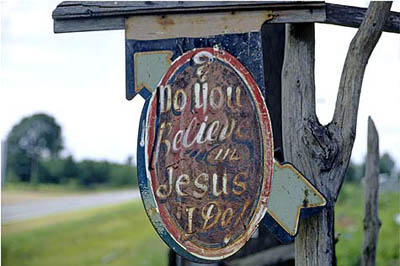 "Do You Believe in Jesus, I Do," Stephen Syke's Place, near Aberdeen, Mississippi, 1966 digital pigment print on Hahnemuhle photo satin paper, 11 x 14 inches William Christenberry Trips and Recent Sculpture Pace/MacGill is pleased to announce an exhibition of works by William Christenberry, featuring over thirty 11 x 14 inch digital pigment prints from never-before-seen transparencies made on various trips to Alabama and Tennessee (1966-84). These will be exhibited together with several large-format prints (44 x 55 inches) and several of Christenberry's recent "Dream Buildings" and found-object sculptures. Drawn from the material culture of the artist's native region, the subjects of these works range from the weathered exteriors of humble buildings to the commercial and handmade signs that color the local landscape. Though the photographs build on the documentary tradition of Walker Evans, Christenberry undertakes a more prolonged study of place and the forces that alter it. His most frequent subjects, like the "Palmist Building" and "Green Warehouse" included in the exhibition, take on an iconic quality as memories of a disappearing past. Giving three-dimensional form to many of the motifs found in the photographs, Christenberry's sculptures combine elements of Dada and Surrealism - such as the incorporation of found objects - with an iconography indigenous to the American South. His "Dream Buildings," for example, evoke the architecture of Southern churches and tenant homes while their recurring triangular and pyramidal shapes suggest the tall, pointed hoods worn by members of the Ku Klux Klan. While the visual content of Christenberry's work derives from a particular locale, the compositions convey universal themes: the effects of time and decay, memory and imagination, and the dynamic relationship between man-made structures and their environment. William Christenberry was born in Tuscaloosa, Alabama, in 1936, the same year that James Agee and Walker Evans collaborated in nearby Hale County on work that would become "Let Us Now Praise Famous Men," a literary and photographic portrait of Alabama sharecroppers during the Great Depression. Once Christenberry discovered the second edition of the book in 1960, its sympathetic depiction of poor tenant farmers came to have a deep and enduring impact on his art. After meeting in New York the following year, he and Evans became lifelong friends and with the latter's encouragement Christenberry began seriously to pursue photography over his early explorations in abstract painting. First using a handheld Kodak Brownie and later a number of larger cameras, he captured the life, landscape, and vernacular architecture of Hale County as well as how they changed over time, often returning to the same subjects year after year for decades to chronicle their physical transformation. This record of Southern culture has also encompassed the threatening presence of the Ku Klux Klan, which Christenberry has treated extensively in various media since the early 1960s. Since 1968, Christenberry has been a professor at the Corcoran College of Art and Design, Washington DC. He has also taught at Memphis State University, Memphis, Tennessee, and the University of Alabama, Tuscaloosa, where he received his BA and MA (1958-59) as well as an honorary PhD (1998). His work has been the subject of dozens of solo shows and exhibitions over the last forty years, and can be found in the permanent collections of the Corcoran Gallery of Art, the Smithsonian American Art Museum and The Phillips Collection, Washington, DC; the Museum of Modern Art and the Whitney Museum of American Art, New York, NY; the Baltimore Museum of Art, Baltimore, MD; Yale University Art Gallery, New Haven, CT; The High Museum of Art, Atlanta, GA; the Stedelijk Museum, Amsterdam, The Netherlands; the Die Photographische Sammlung Stiftung Kultur, Cologne, Germany; the Addison Gallery of American Art, Phillips Academy, Andover, MA; the San Francisco Museum of Modern Art, San Francisco, CA; the International Museum of Photography, George Eastman House, Rochester, NY; the Milwaukee Museum of Art, Milwaukee, WI; the Menil Collection, Houston, TX; the Philadelphia Museum of Art, Philadelphia, PA; the Center for Creative Photography, Tucson, AZ; Smith College of Art, Amherst, MA; and the Kemper Museum of Art, Kansas City, KS. The Pace/MacGill exhibition coincides with the multimedia retrospective "Passing Time: The Art of William Christenberry," on view through July 8, 2007 at the Smithsonian American Art Museum, Washington, DC. Exhibition: September 7 - October 14, 2006 Gallery hours: Tues-Fri 9:30 am - 5:30 pm, Sat 10 am - 4 pm Pace/MacGill Gallery 32 East 57th Street, 9th floor USA-New York, NY 10022 Telephone +1 212 759 7999 Fax +1 212 759 8964 Email info@pacemacgill.com www.pacemacgill.com |